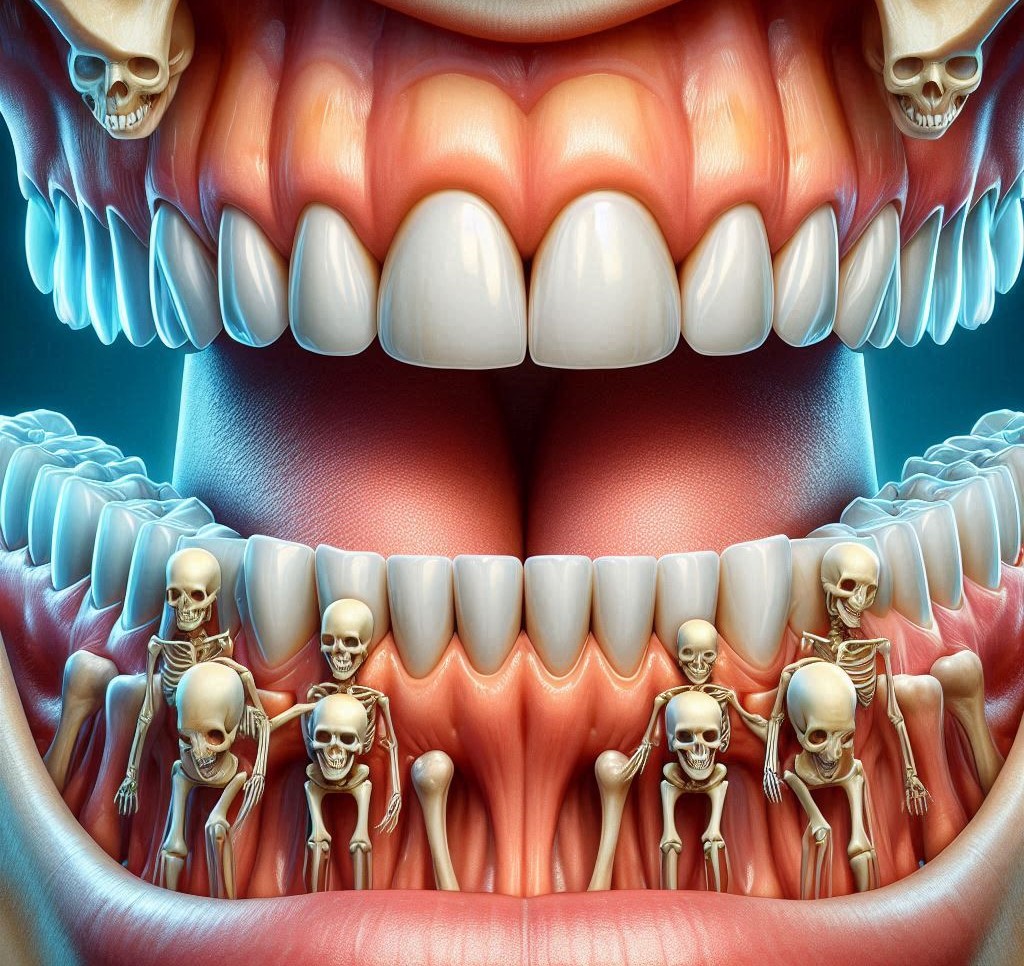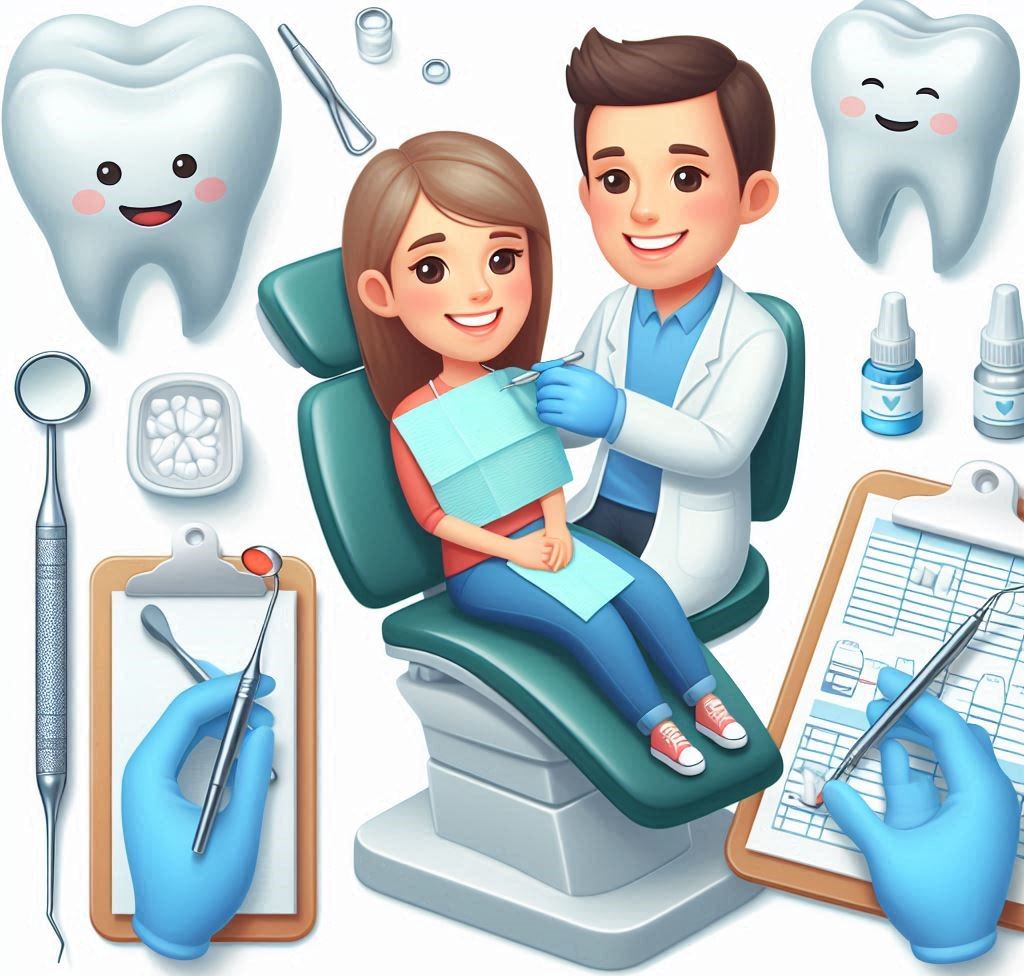Dental health is often seen as something that only requires attention when problems arise—like a cavity, gum disease, or the occasional toothache. However, there are numerous other conditions that can affect the teeth and bones in the mouth, many of which are not immediately apparent. One of these conditions is the development of extra teeth, also known as supernumerary teeth, as well as abnormal bone growth in the oral cavity.
While not as common as more well-known dental issues, these conditions can have a significant impact on oral health if not properly managed. Some people may have extra teeth growing where they shouldn’t, while others may develop abnormal bone structures that interfere with the normal development of the jaw, facial appearance, and overall function. In this article, we’ll explore the causes, symptoms, diagnosis, and treatment options for extra teeth and abnormal bone growth, and why it’s essential to understand these conditions in order to maintain optimal dental health.
What Are Extra Teeth?
Extra teeth, or supernumerary teeth, are teeth that appear in addition to the normal set of 32 adult teeth. This condition is relatively rare, but it can occur in both children and adults. The extra teeth can be located anywhere in the mouth, but they most commonly appear in the upper jaw between the two central incisors, a phenomenon known as mesiodens.
There are several types of supernumerary teeth, each with distinct characteristics:
- Mesiodens: An extra tooth that forms between the two upper central incisors, which is the most common type of supernumerary tooth.
- Paramolars: Extra teeth that emerge near the molars or premolars.
- Distomolars: Also known as “fourth molars,” these extra teeth develop behind the third molars (wisdom teeth).
Causes of Extra Teeth
The development of extra teeth can occur due to various reasons. The most common causes include:
- Genetic factors: Family history may play a significant role in the development of supernumerary teeth. People who have close relatives with the same condition are more likely to develop extra teeth themselves.
- Syndromes: Certain genetic syndromes are linked to the development of supernumerary teeth, including Gardner’s syndrome, Cleft lip and palate, and Crouzon syndrome. These syndromes may cause additional complications and affect other aspects of a person’s health.
- Environmental factors: Trauma, infections, and other environmental factors can sometimes influence the development of extra teeth.
What Is Abnormal Bone Growth?
Abnormal bone growth in the mouth refers to the formation of bone structures that deviate from the norm. While bone growth is a natural process, when it becomes excessive or abnormal, it can lead to complications in both appearance and function. There are a few types of abnormal bone growth that may occur in the oral cavity:
- Exostoses: These are bony growths that form on the surface of the jawbone. They can be found on the roof of the mouth (palatal exostosis) or the inside of the lower jaw (mandibular exostosis).
- Osteomas: These are benign tumors of the bone that can grow in various parts of the body, including the jaw. Osteomas may not cause immediate symptoms, but they can lead to issues such as difficulty chewing, pain, or obstruction of other dental structures.
- Fibrous dysplasia: This condition involves abnormal bone growth that results from the replacement of normal bone with fibrous tissue. This can cause deformities in the jaw or facial bones, and the affected area may become weaker and more prone to fractures.
How Extra Teeth and Abnormal Bone Growth Affect Oral Health
Extra teeth and abnormal bone growth can have a significant impact on oral health, particularly in terms of how the teeth and jaw function. For example, extra teeth can disrupt the normal alignment of teeth, causing bite problems, overcrowding, or even impaction (when a tooth is unable to erupt normally through the gum).
Abnormal bone growth, on the other hand, can lead to jaw deformities, affecting a person’s ability to speak, chew, or smile properly. In some cases, these conditions can also interfere with the eruption of normal teeth, leading to further complications that may require orthodontic treatment or even surgery.
How Extra Teeth and Abnormal Bone Growth Affect Oral Health
Disruption of Tooth Alignment and Bite
One of the most significant ways extra teeth can affect oral health is by disrupting the natural alignment of the other teeth. When extra teeth emerge in the mouth, they may push against adjacent teeth, leading to crowding or misalignment. This can cause a variety of problems such as difficulty chewing, speaking, or even maintaining proper oral hygiene. For example, when teeth are crowded, it can become harder to floss or brush between them, increasing the risk of cavities, gum disease, and other oral health issues.
Extra teeth can also interfere with the way the upper and lower teeth come together when a person bites, known as the bite or occlusion. A misaligned bite can lead to problems like malocclusion, which includes conditions like overbite, underbite, crossbite, or open bite. These bite issues not only affect a person’s appearance but can also result in pain and discomfort, especially in the jaw or temporomandibular joint (TMJ). In severe cases, surgery or orthodontics may be needed to correct the bite and bring the teeth back into proper alignment.
Impact on the Development of the Jaw and Face
Extra teeth, especially when they are numerous or positioned in unusual places, can have a long-term impact on the development of the jaw and facial structures. In children, these extra teeth may disrupt the natural eruption pattern of primary (baby) teeth and permanent teeth. As a result, the child’s jaw may develop asymmetrically or unevenly, which could lead to a misaligned bite or other skeletal abnormalities.
Additionally, abnormal bone growth can lead to similar disruptions. For instance, exostoses (bony growths on the jaw) can cause asymmetry in the face, especially if the growths are large or located in visible areas. While these conditions are typically benign, they can lead to discomfort, functional limitations, or esthetic concerns.
Potential Risks: Infections, Cysts, and Tumors
Both extra teeth and abnormal bone growths can lead to various complications if left untreated. For example, extra teeth that are impacted (unable to break through the gum line) can lead to infections or abscesses. When these extra teeth are not extracted in a timely manner, they can create pockets of bacteria, leading to painful infections that may require antibiotics or surgical drainage.
Additionally, impacted supernumerary teeth can contribute to the development of cysts, especially around the crown of the tooth. Dental cysts are fluid-filled sacs that can cause swelling, discomfort, and further disruption to the surrounding teeth and bone. In rare cases, supernumerary teeth can even lead to the formation of benign tumors or lead to the growth of certain types of oral cancers if left unchecked.
Abnormal bone growths, such as osteomas or fibrous dysplasia, may also cause complications. For example, a large osteoma can interfere with the alignment of other teeth or obstruct the airways. Even if these growths are benign, their presence can cause problems with chewing, swallowing, or breathing, requiring surgical removal to alleviate these symptoms.
Signs and Symptoms You Should Watch For
It’s crucial to understand the signs and symptoms that could indicate the presence of extra teeth or abnormal bone growth. Catching these conditions early can lead to better treatment outcomes and minimize complications. Here’s what you should look out for:
Signs of Extra Teeth
- Visible Extra Teeth: In some cases, extra teeth may emerge through the gums, making them visible. For example, a mesiodens might appear between the two upper central incisors, forming a noticeable extra tooth.
- Crowding or Misalignment: As extra teeth push against surrounding teeth, they may cause crowding or misalignment. This may lead to noticeable gaps or crooked teeth, especially as the permanent teeth start to emerge.
- Delayed Eruption: Sometimes, extra teeth can delay the eruption of permanent teeth. If you notice that your child’s adult teeth are coming in later than expected or are misaligned, this could indicate the presence of supernumerary teeth.
- Pain or Discomfort: Extra teeth may cause pain or discomfort, particularly if they are impacted or pushing against neighboring teeth. This discomfort may be localized or more generalized in the mouth.
Symptoms of Abnormal Bone Growth
- Swelling or Lump in the Mouth: Abnormal bone growth often presents itself as a lump or swelling in the mouth, particularly along the roof of the mouth (palatal exostosis) or inside the jaw.
- Difficulty Chewing or Speaking: If abnormal bone growth interferes with the normal function of the teeth or jaw, it can cause difficulty chewing, speaking, or even swallowing.
- Pain or Tenderness: While abnormal bone growth may not always be painful, larger growths like osteomas can cause pain due to pressure on surrounding tissues.
- Facial Asymmetry: In some cases, especially with conditions like fibrous dysplasia, abnormal bone growth can cause visible facial asymmetry. This can affect the appearance of the jaw, cheekbones, or even the nose.
What to Do If You Notice These Symptoms
If you notice any of these signs or symptoms, it’s important to see your dentist as soon as possible. Even if there is no pain or discomfort, extra teeth or abnormal bone growth should be evaluated to determine whether they require treatment. Early diagnosis can prevent further complications, and treatment can often be more straightforward if caught early.
Diagnosis of Extra Teeth and Abnormal Bone Growth
Diagnosing extra teeth and abnormal bone growth typically involves a combination of clinical exams, patient history, and diagnostic imaging. Here’s how your dentist will approach diagnosis:
Clinical Examination
During a routine dental check-up, your dentist will visually inspect your teeth and gums for any signs of extra teeth or abnormal bone growth. They may also feel for any unusual bumps or lumps on the jaw or palate. If they detect something concerning, they will typically recommend further diagnostic tests.
Radiographic Imaging
- X-rays: One of the most common ways to detect extra teeth is through dental X-rays. These images allow the dentist to see the position of the teeth under the gums, including any supernumerary teeth that might not yet have erupted. X-rays also help identify the location and size of any abnormal bone growths, such as osteomas or exostoses.
- CT Scans: In more complex cases, a CT scan may be necessary to get a more detailed 3D image of the bones in the mouth and face. This helps dentists and oral surgeons plan treatments for abnormal bone growth or supernumerary teeth that might be difficult to access.
Referral to Specialists
If your dentist suspects that the condition is more complex, they may refer you to a specialist, such as an oral surgeon or an oral pathologist, who can provide more advanced diagnostics and treatment options.
Treatment Options for Extra Teeth
The treatment for supernumerary teeth largely depends on their size, location, and the impact they are having on the surrounding teeth and oral health. Here are the common treatment options:
Extraction of Supernumerary Teeth
If an extra tooth is causing problems, such as crowding, impaction, or infection, your dentist may recommend extraction. In cases where the extra tooth is clearly visible and accessible, the extraction may be straightforward. However, for impacted teeth (those that haven’t emerged from the gum line), a more invasive procedure may be needed, which might require surgery.
Orthodontic Treatment
If the presence of extra teeth has caused misalignment or bite issues, orthodontic treatment may be required to straighten the remaining teeth. Braces or clear aligners can be used to reposition the teeth into their proper places. In some cases, orthodontics may be necessary even after extraction to fully align the teeth.
Surgical Removal
For more complex cases, particularly when extra teeth are located deep within the jaw or are causing damage to the bone or other teeth, surgical intervention may be required. This often involves a minor surgery to remove the extra tooth and allow the surrounding teeth and bone to heal properly.
Treatment Options for Abnormal Bone Growth
Treatment for abnormal bone growth in the oral cavity depends on the type of growth, its size, and whether it is causing symptoms. Here are some common approaches:
Surgical Removal
If the abnormal bone growth is large, painful, or causing functional issues (like difficulty chewing or speaking), surgical removal is often the most effective treatment. For example, exostoses may need to be shaved down or removed entirely if they’re causing discomfort or interfering with dental work.
Observation and Monitoring
In some cases, particularly with benign bone growths like small osteomas or fibrous dysplasia, your dentist or oral surgeon may recommend simply monitoring the condition over time. If the growth does not interfere with normal function and does not cause pain or cosmetic concerns, it may not require immediate intervention.
Physical Therapy and Jaw Exercises
If the abnormal bone growth has led to functional issues with the jaw or TMJ, physical therapy and jaw exercises may be recommended to alleviate pain, improve mobility, and restore proper function.
Preventing and Managing Oral Health Complications
Maintaining good oral hygiene and regular dental visits is crucial in preventing complications related to extra teeth and abnormal bone growth. Here are some key practices to follow:
Oral Hygiene Practices
- Brushing and Flossing: Proper brushing and flossing are essential for keeping the teeth and gums healthy, especially if extra teeth are causing crowding. Flossing may be more challenging, but it’s critical to prevent plaque buildup between teeth and reduce the risk of cavities and gum disease.
- Use of Mouthwash: Antiseptic mouthwashes can help reduce bacterial growth, especially in areas that are hard to clean, like between crowded teeth or around impacted teeth.
Diet and Lifestyle
- Avoid Sugary Foods: A diet high in sugars can increase the risk of cavities and gum disease. Eating a balanced diet rich in vitamins and minerals helps support healthy teeth and bones.
- Calcium and Vitamin D: These nutrients are vital for bone health. Ensuring adequate intake can help prevent and manage bone conditions, especially in cases of abnormal bone growth.
Regular Dental Check-ups
- Regular dental visits allow your dentist to monitor the condition of your teeth and jaw, detect any abnormalities early, and treat them promptly. Early intervention is key to minimizing complications.
The Psychological and Social Impact of Oral Conditions
Dental conditions like extra teeth and abnormal bone growth can affect more than just physical health—they can also take a toll on a person’s self-esteem and mental well-being. Here’s how these conditions can impact a person socially and emotionally:
Impact on Self-esteem
People with noticeable dental issues may feel self-conscious about their appearance, leading to a reduced quality of life. Whether it’s extra teeth that cause crowding or abnormal bone growth that results in facial asymmetry, many individuals struggle with their confidence and how they are perceived by others. This can affect social interactions and even job prospects in some cases.
Emotional Struggles
The pain and discomfort associated with abnormal bone growth or extra teeth can also affect mental health. Chronic pain can lead to irritability, stress, and feelings of frustration, while difficulties with chewing or speaking may limit a person’s ability to engage in normal social activities.
Coping with Dental Conditions
It’s important for patients with these conditions to seek not only dental treatment but also psychological support if needed. Dentists are trained to handle these issues sensitively and often work alongside orthodontists and oral surgeons to create a comprehensive treatment plan. Psychological counseling or support groups may also help patients cope with emotional challenges.
What Your Dentist Wishes You Knew
Dentists are your best allies in maintaining oral health, and they want you to be informed about the conditions that affect your teeth and bones. Here are a few things your dentist wishes you knew:
Communication Is Key
Don’t hesitate to ask your dentist questions about your oral health, and be sure to mention any concerns you may have. Whether it’s about pain, discomfort, or appearance, discussing your symptoms openly can lead to a more accurate diagnosis and tailored treatment plan.
Preventive Care Is Essential
Your dentist’s goal is to help you avoid serious oral health problems. Regular check-ups, cleanings, and timely interventions are the best ways to prevent conditions like extra teeth and abnormal bone growth from causing lasting damage.
Early Intervention Leads to Better Outcomes
The earlier a dental issue is detected, the easier it is to treat. Don’t wait until you’re in pain or experiencing discomfort—schedule regular appointments and get your teeth checked regularly, especially if you have a family history of dental issues.
Conclusion
Understanding extra teeth and abnormal bone growth in the mouth is important for maintaining long-term oral health. These conditions may seem rare, but they can have significant impacts if left untreated. By being aware of the signs and symptoms and seeking early diagnosis and treatment, you can prevent many of the complications associated with these conditions.
Remember to communicate openly with your dentist, practice good oral hygiene, and schedule regular check-ups to keep your teeth and gums in top shape. With the right care and attention, you can avoid potential problems and enjoy a healthy, confident smile for years to come.
SOURCES
Akhter, M. P. & Khan, F. (2015). Supernumerary teeth: A review and a case report. Journal of Clinical and Diagnostic Research, 9(12), ZC71-ZC73.
Bai, D., & Dai, J. (2016). Abnormal bone growth in the jaw: Clinical implications. Oral Surgery, Oral Medicine, Oral Pathology and Oral Radiology, 121(4), 339-346.
Gardner, D. (2004). Gardner’s syndrome: Clinical aspects and molecular genetics. The Journal of Clinical Genetics, 58(5), 625-631.
Huang, W., & Chang, M. (2007). Impact of supernumerary teeth on orthodontic treatment: A retrospective study. American Journal of Orthodontics and Dentofacial Orthopedics, 131(2), 179-184.
Liu, J., & Jiang, X. (2018). Diagnosis and management of osteomas in the jaw: A comprehensive review. Journal of Oral and Maxillofacial Surgery, 76(1), 13-19.
Mansour, H. & Elhennawy, K. (2020). Supernumerary teeth: Etiology, clinical considerations, and treatment approaches. European Journal of Dentistry, 14(4), 530-535.
Park, Y., & Lee, W. (2013). The role of genetic and environmental factors in the development of supernumerary teeth. Journal of Dental Research, 92(6), 561-567.
Shah, A., & Gondal, S. (2012). Exostosis and fibrous dysplasia in the oral cavity: An analysis of clinical cases. The Journal of Clinical Oral Investigations, 16(2), 421-427.
Shroff, P., & Deshmukh, S. (2017). Early detection of abnormal bone growth in the oral cavity: A critical review of diagnostic procedures. Journal of Oral Pathology and Medicine, 46(8), 689-696.
Vaidya, S., & Pillai, R. (2019). The psychological impact of abnormal oral health conditions: A review. Journal of Dental and Medical Sciences, 18(5), 42-48.
HISTORY
Current Version
March 3, 2025
Written By:
SUMMIYAH MAHMOOD




